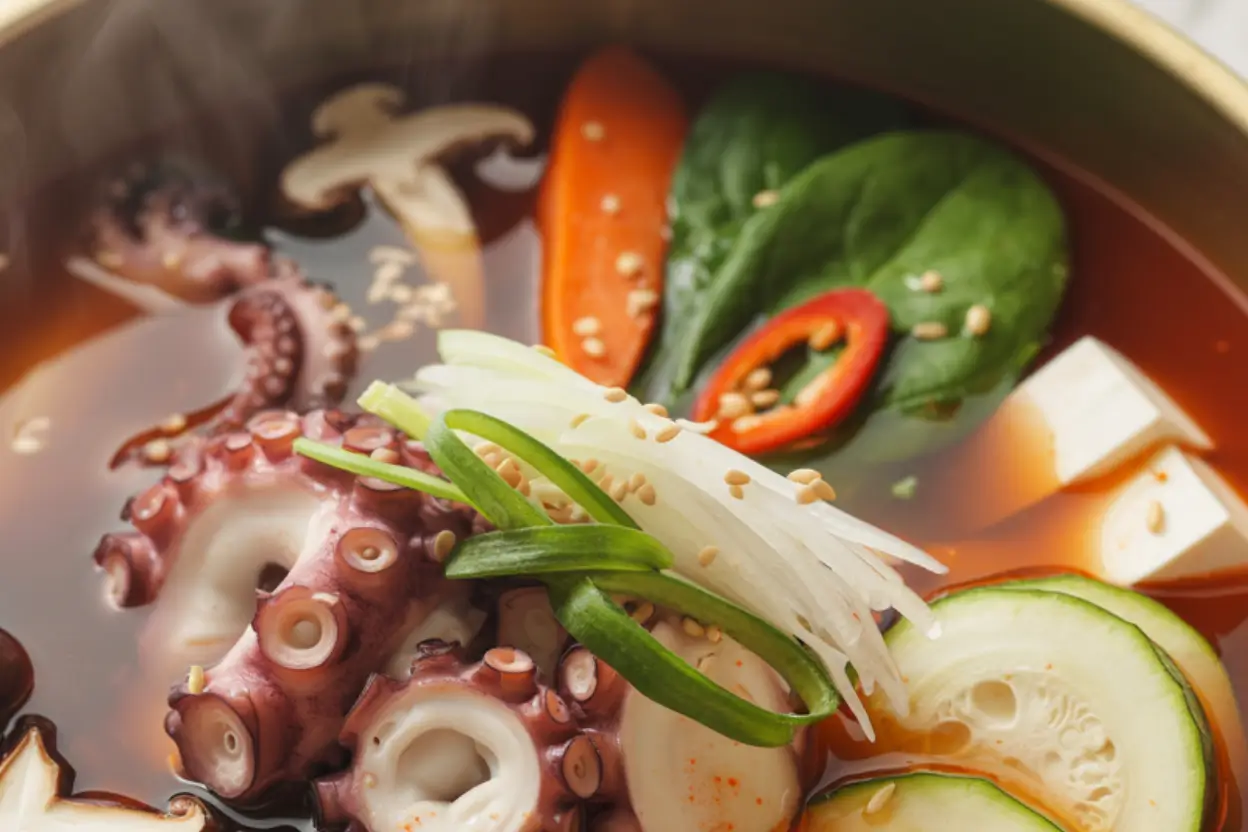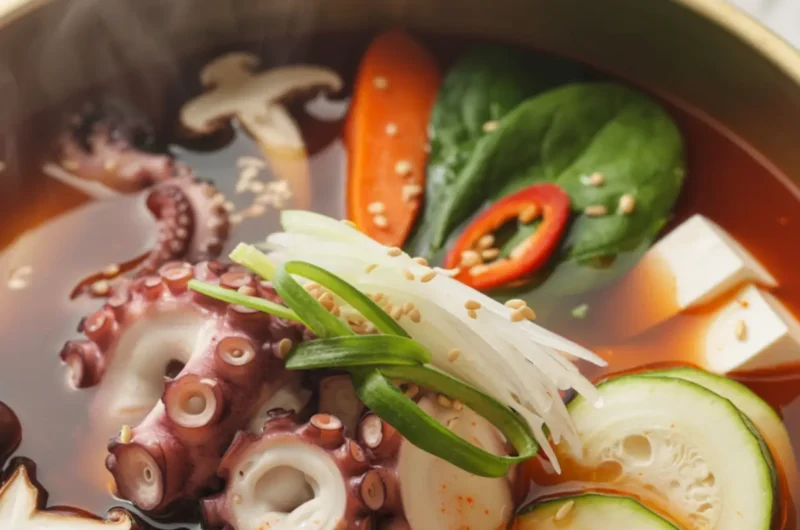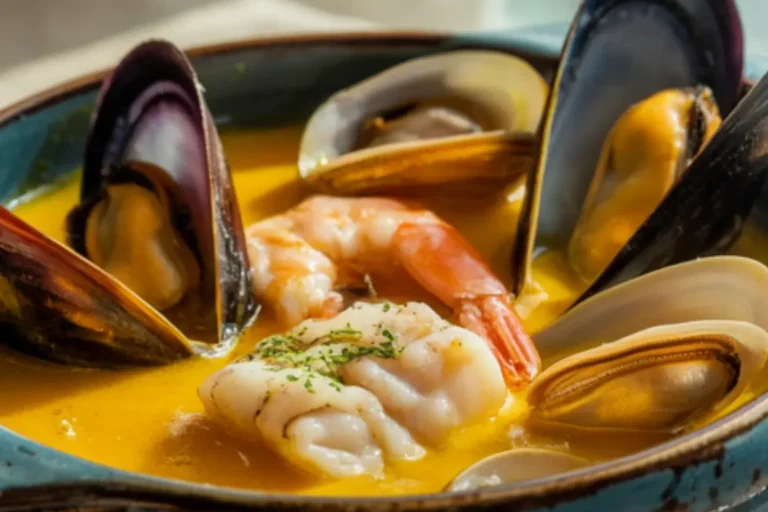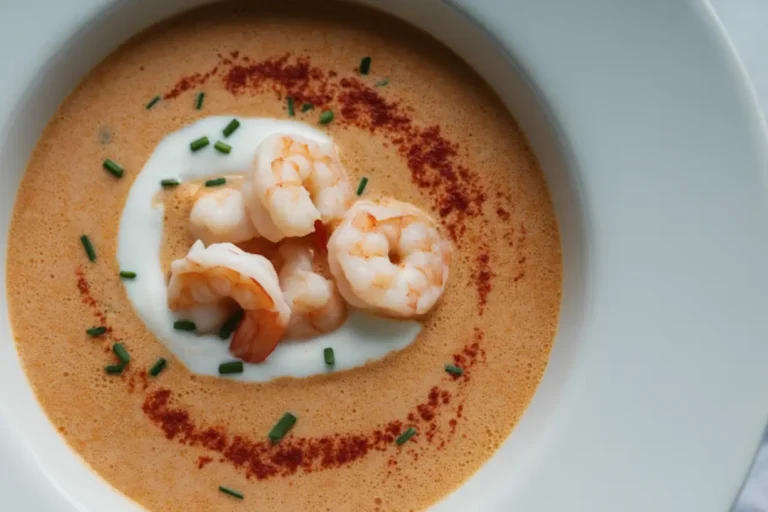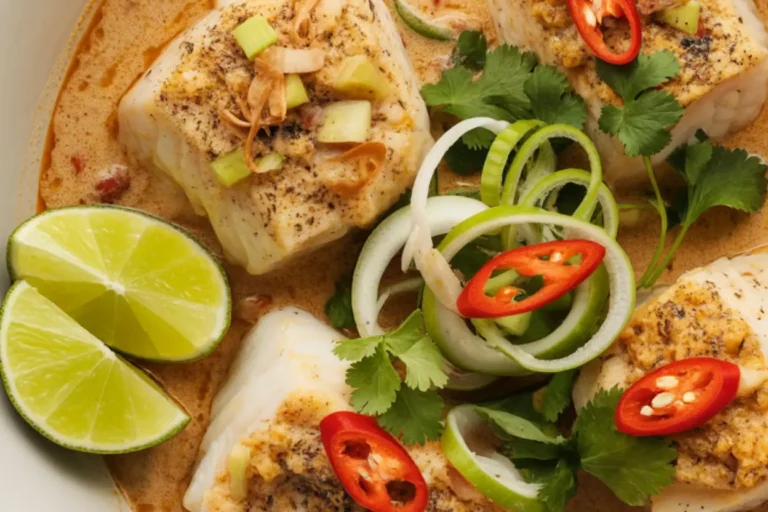Yeonpo Tang: 5 Steps to Master This Korean Octopus Soup
Table of Contents
There’s something deeply comforting about a steaming bowl of Yeonpo tang on a chilly evening. As someone who’s traveled extensively through Korea and studied its regional cuisines, I’ve developed a special appreciation for this nourishing octopus soup from the southern coastal regions. Today, I’m sharing my authentic recipe for Yeonpo tang that will transport your taste buds straight to the bustling seafood markets of Busan.
Thank you for reading this post, don't forget to subscribe!How to Make Yeonpo Tang
Quick Overview
Yeonpo tang is a soul-warming Korean octopus soup that balances the natural sweetness of fresh octopus with the vibrant depth of Korean seasonings. Unlike many other Korean soups that require hours of simmering, this seafood delicacy comes together in just about 45 minutes, making it accessible for weeknight cooking yet impressive enough for weekend entertaining.
What makes this soup truly special is its clean, clear broth that’s surprisingly complex in flavor. The octopus releases its natural essence into the soup, creating a delicate oceanic base that’s enhanced with garlic, ginger, and mild Korean chilies. The tender chunks of octopus provide a satisfying bite without being chewy, while the addition of silken tofu and fresh vegetables adds textural contrast and nutritional balance.
Whether you’re looking to expand your Korean cooking repertoire or simply craving a nourishing seafood soup, Yeonpo tang offers the perfect combination of familiar comfort and exotic flavor that will have you returning to this recipe again and again.
The Ingredients I Use to Bring My Yeonpo Tang to Life
For the Octopus:
- 1 medium octopus (about 2 lbs or 900g), cleaned
- 1 tablespoon coarse sea salt (for cleaning)
For the Broth Base:
- 8 cups of water
- 1 medium onion, quartered
- 6 cloves garlic, lightly crushed
- 1-inch piece of ginger, sliced
- 2 green onions, white parts only (reserve green parts for garnish)
- 2 tablespoons Korean soy sauce (ganjang)
- 1 tablespoon fish sauce
- 1 teaspoon sea salt (adjust to taste)
Vegetables and Additional Ingredients:
- 1 medium zucchini, cut into half-moons
- 1 medium carrot, sliced
- 8 oz (225g) soft tofu, cubed
- 1 cup fresh spinach leaves
- 3 dried shiitake mushrooms, soaked in warm water for 30 minutes and sliced
- 2 Korean green chilies, sliced (adjust according to heat preference)
- 1 Korean red chili, sliced (optional, for color and mild heat)
Seasoning:
- 1 tablespoon gochugaru (Korean chili flakes)
- 1 tablespoon sesame oil
- 1 tablespoon roasted sesame seeds
- 2 tablespoons chopped green onion (green parts)
- Fresh perilla leaves, thinly sliced (optional)
Step-by-Step Instructions
Step 1: Prepare the Octopus
- Cleaning the octopus: Place the octopus in a large bowl and rub it thoroughly with coarse sea salt. This helps remove any sliminess and impurities from the surface. Rinse the octopus under cold running water, making sure to clean between the tentacles.
- Removing inedible parts: Turn the octopus over to expose the center where all the tentacles meet. Using a sharp knife, cut out the beak (the hard, center part) and remove the eyes and ink sac if not already done.
- Tenderizing: For a more tender result, gently pound the octopus with a meat mallet or the back of a knife. Alternatively, you can freeze the cleaned octopus for 1-2 hours before cooking, which also helps tenderize it.
- Sizing: Cut the octopus into bite-sized pieces, roughly 2 inches in length. Keep the tentacles slightly longer as they’ll shrink during cooking.
Step 2: Create the Flavorful Broth
- Start the soup base: In a large pot, add the water, quartered onion, crushed garlic, ginger slices, and white parts of the green onions. Bring to a boil over medium-high heat.
- Add seasonings: Once boiling, reduce the heat to medium and add the Korean soy sauce and fish sauce. Let the broth simmer for about 15 minutes to develop a fragrant base.
- Strain the broth: Using a fine-mesh strainer, remove the solids from the broth, returning the clear liquid to the pot. This creates the clean, clear broth characteristic of authentic Yeonpo tang.
Step 3: Cook the Octopus
- Add octopus to broth: Return the broth to a gentle boil and add the octopus pieces. Reduce to a simmer and cook for approximately 20 minutes, or until the octopus is tender when pierced with a fork. The cooking time may vary depending on the size and freshness of your octopus.
- Test for doneness: Occasionally check a piece of octopus – it should be tender but still have some resistance when bitten. Overcooked octopus will become rubbery, while perfectly cooked octopus will have a pleasant chewiness.
- Skim the surface: Throughout the cooking process, use a fine-mesh skimmer to remove any foam or impurities that rise to the surface. This ensures a clean-tasting, clear broth.
Step 4: Add Vegetables and Tofu
- Introduce vegetables in stages: Once the octopus is nearly tender (about 15 minutes into cooking it), add the sliced carrots and soaked shiitake mushrooms, as they take longer to cook.
- Add remaining ingredients: After 5 more minutes, add the zucchini slices, tofu cubes, and sliced Korean chilies. Simmer for another 3-5 minutes until the vegetables are tender but not mushy.
- Finish with delicate ingredients: In the last minute of cooking, add the spinach leaves and stir gently. They will wilt quickly in the hot broth.
Step 5: Season and Serve
- Final seasonings: Turn off the heat and stir in the gochugaru and sesame oil. Taste and adjust salt if necessary.
- Garnish the soup: Ladle the Yeonpo tang into individual serving bowls. Garnish with the chopped green onions, roasted sesame seeds, and thinly sliced perilla leaves if using.
- Present authentically: For traditional serving, place the soup bowls on the table while still steaming hot, alongside small dishes of additional gochugaru for those who prefer extra heat.
What to Serve Yeonpo Tang With
Yeonpo tang shines as the star of any Korean meal, but it becomes even more special when accompanied by these complementary dishes:
Rice Accompaniments:
- Steamed short-grain rice: The essential foundation for any Korean meal, perfect for soaking up the flavors of the soup.
- Nurungji (crispy rice): Scorched rice from the bottom of the pot provides a delightful textural contrast to the soup.
Banchan (Side Dishes):
- Kimchi: The fermented cabbage side dish is a must-have with any Korean soup, providing a tangy contrast.
- Gamja jorim: Braised potatoes in a sweet and savory sauce balance the oceanic flavors of the soup.
- Kongnamul muchim: Sesame oil and green onions season bean sprouts, providing a fresh, crunchy contrast.
- Oi muchim: Spicy cucumber salad provides a cooling element to balance the warmth of the soup.
Beverages:
- Barley tea (boricha): This roasted grain tea cleanses the palate between bites and aids digestion.
- Dongchimi: A mild, watery radish kimchi that works as both a side dish and a refreshing drink.
- Sikhye: A sweet rice drink traditionally served at the end of meals to aid digestion.
For a complete traditional meal, serve the soup alongside 3-4 banchan, rice, and a refreshing beverage. This creates the balanced harmony of flavors, textures, and temperatures that defines Korean cuisine.

Top Tips for Perfecting Yeonpo Tang
Selecting the Perfect Octopus:
- Freshness is key: Look for octopus with a clean ocean smell, bright color, and firm texture. Avoid any with a fishy odor or slimy coating.
- Size matters: Medium-sized octopus (1.5-2.5 lbs) works best for this soup. Too small and it will overcook quickly; too large and it may be tough.
- Frozen option: If fresh isn’t available, frozen octopus is a good alternative. Thaw it slowly in the refrigerator overnight for the best texture.
Tenderizing Techniques:
- Traditional Korean method: Blanch the octopus in boiling water for 30 seconds, then immediately plunge into ice water. Repeat 2-3 times before adding to the soup.
- Citrus tenderizing: Marinating the octopus pieces in lemon or lime juice for 20 minutes before cooking can help tenderize the meat.
- Patience is a virtue: Never rush the simmering process. Low and slow cooking is essential for tender octopus.
Broth Clarity:
- Cold water start: Always begin with cold water when making the broth for the cleanest result.
- Consistent skimming: Removing foam throughout the cooking process is crucial for a clear, clean-tasting soup.
- Gentle simmer: Keep the heat low enough that the soup barely bubbles. Violent boiling clouds the broth and toughens the octopus.
Vegetable Variations:
- Seasonal adaptations: In summer, add lighter vegetables like zucchini and fresh greens. In winter, incorporate heartier root vegetables like radish or potato.
- Texture balance: Always include something soft (tofu), something leafy (spinach), and something with bite (mushrooms) for a well-rounded soup experience.
Common Mistakes to Avoid:
- Overseasoning early: Wait until the end to adjust the final seasoning. The octopus will release natural flavors as it cooks.
- Adding all vegetables at once: Each vegetable has its optimal cooking time. Add them in stages for perfect texture.
- Stirring too vigorously: Stirring gently helps maintain the tofu’s integrity and keeps the broth clear.
- Rushing the process: The magic of Yeonpo tang happens in the slow development of flavors. Give it time.
Storing and Reheating Tips
Yeonpo tang can be stored and enjoyed as leftovers, though, like most seafood dishes, it’s best consumed soon after preparation.
Refrigeration:
- Cool properly: Allow the soup to cool to room temperature before refrigerating, but don’t leave it out for more than 2 hours for food safety.
- Storage containers: Use airtight glass containers rather than plastic, which can absorb seafood flavors.
- Storage period: Properly stored Yeonpo tang will maintain its quality in the refrigerator for up to 2 days. After this, the texture of the octopus may deteriorate.
- Separation is normal: The broth may appear gelatinous when cold due to natural collagen from the octopus. This is a sign of a well-made soup.
Freezing Guidelines:
- Component separation: For best results when freezing, separate the broth from the octopus and vegetables. The broth freezes well for up to 3 months, but the octopus and vegetables are best consumed fresh.
- Freezing portions: If you must freeze the complete soup, do so in single-serving portions for easier reheating.
- Freeze protection: Use freezer-safe containers with minimal air space to prevent freezer burn.
- Labeling: Always mark containers with the date and contents for easy identification.
Reheating Methods:
- Stovetop (preferred): Reheat the soup gently over medium-low heat, stirring occasionally until it reaches a gentle simmer. Avoid boiling, which will toughen the octopus further.
- Microwave (quick option): Heat individual portions on 70% power in 1-minute intervals, stirring between each interval until heated through. Use a microwave-safe bowl covered with a vented lid or paper towel.
- Refreshing taste: When reheating, add a splash of fish sauce or a squeeze of fresh lime juice to brighten the flavors that may have dulled during storage.
- Texture revival: Add fresh chopped green onions or perilla leaves after reheating to revive the vibrant appearance and flavor of the dish.
Making Ahead for Guests:
If preparing Yeonpo tang for guests, consider making the broth and cooking the octopus the day before, then storing them separately. On the day of serving, reheat the broth, add the octopus to warm through, and then add fresh vegetables and tofu. This provides the convenience of make-ahead preparation while maximizing the fresh qualities of the dish.
Yeonpo tang represents the perfect harmony of land and sea in Korean cuisine. Its delicate balance of flavors and nourishing qualities makes it an ideal showcase for fresh octopus. While it might seem intimidating at first, following these detailed steps will lead you to create a restaurant-quality octopus soup that honors this traditional Korean delicacy. Share this warming, flavor-packed soup with loved ones, and watch as they discover the subtle complexities that make Yeonpo tang so beloved in Korean culinary tradition.
Yeonpo Tang: 5 Steps to Master This Korean Octopus Soup
Cuisine: KoreanDifficulty: Medium4
servings20
minutes40
minutes280–320
kcalYeonpo Tang is a comforting and aromatic Korean soup made with tender octopus simmered in a clear broth infused with garlic, ginger, soy sauce, and chilies. Filled with fresh vegetables, tofu, and optional herbs like perilla leaves, it’s a soothing yet flavorful dish perfect for any season.
Ingredients
1 medium octopus (about 2 lbs or 900g), cleaned
1 tablespoon coarse sea salt (for cleaning)
8 cups of water
1 medium onion, quartered
6 cloves garlic, lightly crushed
1-inch piece of ginger, sliced
2 green onions, white parts only (reserve green parts for garnish)
2 tablespoons Korean soy sauce (ganjang)
1 tablespoon fish sauce
1 teaspoon sea salt (adjust to taste)
1 medium zucchini, cut into half-moons
1 medium carrot, sliced
8 oz (225g) soft tofu, cubed
1 cup fresh spinach leaves
3 dried shiitake mushrooms, soaked in warm water for 30 minutes and sliced
2 Korean green chilies, sliced (adjust according to heat preference)
1 Korean red chili, sliced (optional, for color and mild heat)
1 tablespoon gochugaru (Korean chili flakes)
1 tablespoon sesame oil
1 tablespoon roasted sesame seeds
2 tablespoons chopped green onion (green parts)
Fresh perilla leaves, thinly sliced (optional)
Directions
- Prepare the Octopus
Begin by thoroughly cleaning the octopus using coarse sea salt to remove any sliminess, then rinse it well under cold water. Remove the beak, eyes, and ink sac if they haven’t already been taken out. To help tenderize the octopus, gently pound it with a meat mallet or freeze it for 1–2 hours. Once cleaned and tenderized, cut it into bite-sized pieces, keeping tentacle pieces slightly longer to account for shrinkage during cooking. - Create the Flavorful Broth
In a large pot, bring 8 cups of water to a boil with a quartered onion, crushed garlic, ginger slices, and the white parts of green onions. Once boiling, reduce the heat and add Korean soy sauce and fish sauce, letting it simmer for about 15 minutes to develop a deep flavor. After simmering, strain out the solids to leave behind a clean and aromatic broth. - Cook the Octopus
Return the clear broth to a gentle boil and add the octopus pieces. Reduce the heat to a simmer and cook for about 20 minutes, until the octopus is tender but pleasantly chewy. Be careful not to overcook, as this can lead to a rubbery texture. Throughout cooking, skim off any foam or impurities to keep the broth clean and clear. - Add Vegetables and Tofu
Add the sliced carrots and soaked shiitake mushrooms first, as they take longer to soften. After about 5 minutes, stir in the zucchini slices, cubed tofu, and sliced chilies. Simmer everything together for an additional 3–5 minutes until the vegetables are cooked but still vibrant. In the final minute, gently add the spinach leaves so they wilt without overcooking. - Season and Serve
Turn off the heat and stir in gochugaru and sesame oil to finish the soup with a hint of warmth and aroma. Taste and adjust salt if needed. Ladle the soup into bowls and garnish with chopped green onions, roasted sesame seeds, and thin slices of perilla leaves if desired. Serve hot with optional extra gochugaru on the side for those who enjoy more spice.
Notes
- Yeonpo Tang is a traditional dish known for its gentle spiciness and clean, oceanic flavor. Cleaning the octopus with coarse salt is essential to remove any sliminess and ensure a tender texture. The addition of soft tofu, fresh vegetables, and a touch of gochugaru gives this light soup both depth and a balanced heat. For an extra layer of freshness, top with sliced perilla leaves and serve with steamed rice or kimchi on the side.

